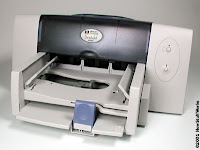
After you have attached the print device to a computer, it is relatively easy to install the printer to the Printers and Faxes folder. In fact, Windows will normally find the print device automatically and configure a printer icon for you. If Windows doesn't find it, use the steps in this task to add the printer yourself.
Run the Add Printer Wizard
In the Printers and Faxes folder, click the Add a Printer link to launch the Add Printer Wizard. When you see the Welcome screen, click Next.
Choose Local Printer
On the first page of the wizard, enable the Local printer option. A local printer is attached directly to your computer (it's not a printer that you reach over the network). A local printer is located in your office; it will not be the printer in the company's printer room or the one attached to Jonnie's computer that you have permission to use.
Don't Detect the Printer Automatically
Disable the option to automatically detect the printer. If Windows didn't find it automatically already, it probably won't now. If you leave this option selected, Windows will attempt to find the printer itself and figure out what kind it is. If Windows does not find the printer, the wizard will continue as described in this task. If Windows does find the printer, it will set it up for you.
Go to the Next Page
Whenever you finish with the options on one wizard page, just click Next to go to the next page.
Choose a Port
Choose the port on your computer to which the print device is attached. The first print device on a computer is usually on the LPT1 port (the first parallel port). The second print device is usually on the LPT2 port (the second parallel port). When you've selected the port, click Next to go on.
Choose a Manufacturer
On the left side of this page is a list of common printer manufacturers. Choose the manufacturer for the print device you are installing.
Choose a Model
After you choose a manufacturer from the left side of the page, the list on the right changes to display printer models made by the selected manufacturer. Choose the model of the print device you are installing. Click Next to go on.
Name the Printer
By default, Windows creates a name for your print device based on its manufacturer and model number (for example, HP DeskJet 855C). If you want the printer icon to have a different name, type a new name in the Printer name text box.
Make It the Default Printer
If you want your new printer to be the default printer used by programs on your computer, click Yes. If you prefer to preserve an existing default printer, click No. Click Next to go on.
Share the Printer
If you want to share the new printer with other users on the network, enable the Share name option. Windows creates a share name for you based on the printer name you selected in Step 8 of this task. If you want, you can type a different share name. For more on sharing a printer, see Task 5, "How to Share a Printer with Others." Click Next to go on.
Enter a Location and Description
Optionally, you can enter a location and description for the printer to help identify it to others who may use it. You won't see this screen if you did not choose to share the printer in Step 10. Whether you fill in these fields or not, click Next to go on.
Print a Test Page
Click Yes if you want Windows to print a test page to ensure that your new printer is working properly. If the test doesn't work, you are shown how to troubleshoot the installation. Click Next to go on.
Finish the Installation
Review the configuration of your new printer. If you discover any problems or errors in this information, click Back to go back through the steps of the installation. If you are satisfied with the information displayed here, click Finish.
Creating a Share Name
When you create a share name for your printer, it is best to keep the name under eight characters in length. Older programs (those created for use with pre-Windows 95) can recognize only eight-character names. If you are at all unsure whether any users of older programs will print to your printer, keep the name short.
Installing a Printer More Than Once
Each icon in the Printers and Faxes folder represents a real printer. You can install more than one icon for a single printer by running the Add Printer Wizard again, choosing the same printer and port during setup, and giving the new icon a new name. You may want to do this to configure each icon with different settings. For example, your printer may have two paper trays: one for letter-size paper and one for legal-size paper. You could name one icon Letter Printer and configure it to use paper from the letter-size paper tray. You could name the other icon Legal Printer and configure it to use the legal-size paper tray. You can also set up additional printer icons to use different print quality, paper types, or whatever other configurations you desire.

